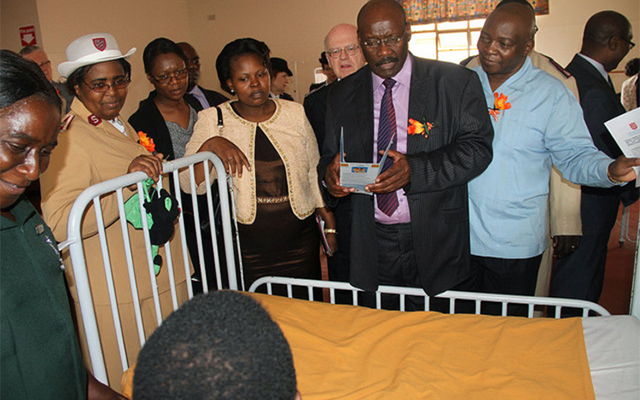Salvation Army 125th celebrations gather momentum


The Salvation Army will celebrate 125 years of existence in Zimbabwe next week
Musavengana Hove ; Features Correspondent
Clad in cream costumes, white-starched blouses and broad hats, a group of Salvation Army women huddle together at their church’s headquarters by Leopold Takawira and Josiah Chinamano. Then they energetically chant, ululate and dance as the rattle shakers (hosho), tambourines and whistles blend perfectly giving out a melodious tune reminiscent of a religious jamboree of the Medieval times.Despite the sweltering summer sun, the session continues only disrupted intermittently as more congregants troop in to join the resolute women polishing their acts.
Throughout the country, hundreds of thousands of Salvation Army congregants are putting final touches to their preparations for the grand celebration of 125 years of their existence in Zimbabwe slated for September 26 to 29 at Glamis Arena in the capital.
Harare is expected to come to a halt as pilgrims across the breadth and length of Zimbabwe and the diaspora are expected to paint the city cream and grey as their military-style uniforms dominate every part of the bustling city. As the preparation for this milestone achievement gathers momentum, the church is wrapping up divisional celebrations across all provinces in the country.

The Salvation Army in Zimbabwe has made several development inroads in the education, health and charity sectors since its birth in the last quarter of the 19th century
The regional celebrations are being done to assess the preparedness of each province towards the big event, which will leave an indelible mark in religion circles.
“Our flag is currently in Masvingo where it is hoisted at every centre to mark this mega event. Congregants are expected to append their signatures in books provided by the church. It’s all systems go my friend,” said an ecstatic congregant who declined to be named because of church protocol.
Salvation Army spokesman Captain Mafukidze confirmed that preparations were at an advanced stage with an estimated 70 000 congregants expected to grace the mega occasion.
“All roads lead to Glamis Arena to mark our 125 years of existence. We are so excited because the celebrations mark 125 years of transforming lives, reforming society and caring for the poor. Everything is in shape and we expect over 70 000 followers to converge at the venue,” said Captain Mafukidze when contacted for a comment.
“We are currently seized with bookings and putting final touches to everything on our venue. We are also conducting our meetings at the venue so as to monitor progress and clear all hurdles which might stand in our way,” said the cleric beaming with joy.
The Salvation Army is celebrating the jumbo event under the theme “Jehovah our strength” and scores of its congregants expressed optimism about the future of the church as it continues to grow in leaps and bounds.
“Unlike other churches in Zimbabwe where leadership wrangles and the spread of morally degrading practices are threatening their image and existence, we as Salvation Army have remained united and steadfast in our quest to spread the gospel of Jesus which centres on love, repentance and forgiveness,” said a congregant only identified as Mai Moyo.
History of the Church in Zimbabwe
The Salvation Army is a dynamic international evangelical church which traces its genesis to 1878 although its roots can be traced even way back when it was referred to as William Booth’s Christian Mission in England.
Over the past 20 years, the church has launched an extensive leadership renewal offensive with over five generals replaced in a short space of time. The current General is Andre Cox who assumed the top post in 2013, replacing General Linda Bond who assumed office in 2011.
According to the Salvation Army, 1891 was its inception year in Zimbabwe and like its counterparts — the Lutheran Church, Roman Catholic Church, the Methodist and the Dutch Reformed Church — they are often accused of spreading Western religion and demonising African cultural beliefs such as ancestral worship and rain-making ceremonies labelling them primitive.
The establishment and growth of the Salvation Army into a formidable and potent force in Zimbabwe, then Southern Rhodesia, is widely attributed to the charismatic leadership of Eva Burrows who was first appointed as an officer teacher to Howard Institute in Mashonaland Central, and later became the world leader of the Salvation Army.
These churches, historians say, were a vital conduit used by imperial powers to subjugate African political systems and establish racist imperial governments on the continent.
Salvation Army and military ties
According to church literature, the denomination started using military insignia and terminology as far as 1878 to symbolise the church’s protracted struggle against poverty and social ills.
“This was much in keeping with popular Christian themes at the time, reflected in well known hymns of that era such as ‘Onwards Christian Soldiers!’,” reads a statement from a Salvation Army publication.
The administration of the Salvation Army is top-down and autocratic, in true military fashion, with virtually all leadership positions except that of General being held by appointment.
Congregants wear military-style uniforms modelled on Victorian military garb at the instigation of the church’s first captain, Elijah Cadman.
The church has also become distinctive and a cut above the rest, with hoisting of a red flag becoming its major feature.
However, the tradition of wearing fully-fledged military-style uniforms is gradually vanishing with members of the church in eastern Australia no longer putting on hats and there are now variations in uniforms internationally because of climate and other local considerations.
The church is also famous worldwide for its vibrant brass bands and well-choreographed choirs which have become permanent features at gatherings such as marriages, open-air meetings, funerals, enrolment of soldiers, farewells and retirements.
Members of the church also say the flag is a precious fetish of their religious practice with the red representing the blood of Jesus, the blue border standing for purity and the yellow star in the centre signifying the fire of the Holy Spirit.
However, despite the recognition given to the Holy Spirit in church regalia and literature, the church is contemptuous of those who purport to speak in tongues and water immersion.
“I was called all sorts of names when the Holy Spirit manifested itself during a Sunday service. I got a strong remonstration for it and was told to renounce it or risk excommunication from the church,” says a young man who claimed to have a “Holy Spirit upon him”.
Another congregant only identified as Takudzwa says the church does not believe in water immersion since repentance of the heart is more important than any other practice that can be interpreted as conversion to Christianity.
“Repentance toward God, faith in our Lord Jesus Christ and regeneration by the Holy Spirit are more important than any practice in Christianity as a religion,” he said defiantly.
Salvation Army on development in Zimbabwe
The Salvation Army in Zimbabwe has made several development inroads in the education, health and charity sectors since its birth in the last quarter of the 19th century.
The church operates four boarding schools with classic facilities in Howard Institute established in 1923, Bradley (1926), Usher Institute (1933) and Mazoe (1959). The church also runs several primary schools across Zimbabwe.
The church is also championing the needs of disadvantaged groups in society such as the old and the orphaned.
According to Church documents, the denomination operates four social services institutions, namely the Bumhudzo Home for the elderly, the Bradley Social Complex, Enterprise House and the Ralstein centre. At the epicentre of the objectives of these philanthropy institutions is provision of accommodation and other basic needs for the elderly and marginalised population in Zimbabwe.
The church also owns Howard Hospital in Mazowe which provides basic medical facilities in the farming community.
During its divisional celebrations held in Bulawayo sometime in April, Bulawayo Metropolitan Residential Minister Cde Nomthandazo Eunice Moyo lauded the church for fulfilling the Zim-Asset clusters of social service by providing accommodation to the destitute and employment creation.
“I am proud to mention that as a church you did not end there (social service) but went further to fulfil the infrastructure and utilities cluster where you were seen drilling boreholes to alleviate the shortage of water,” remarked minister Moyo.
The church recently embarked on livestock restocking project under which impoverished and marginalised communities are given cattle and coats, thereby empowering them.









Comments